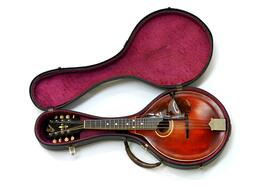Gibson A-4 Mandolin Takes Centre Stage
Gibson A-4 Mandolin Takes Centre Stage
By Elizabeth Talbot
A mandolin is a member of the lute family; it usually has a pear-shaped body, fretted neck and four to six pairs of strings. The lute has its origins in one of the earliest forms of musical instrument known to humankind, a simple one-stringed instrument. There are beautiful cave paintings in France, dated to between 15,000BC and 8,500BC, which illustrate this. Originally, they were played by plucking the string with the fingers and then by tapping the string with a stick. Volume was increased by holding the instrument in the player’s mouth; later gourds were attached to instruments to act as resonators, hence the evolution of the shape.
Early lute-like instruments appeared as early as 2000 BC in Mesopotamia. These were fretless and so changes in pitch were made by pressing the strings down onto the neck of the instrument. The strings were sometimes plucked by using hard objects or plectrums and this produced a louder, sharper, sound than the fingers. The ancient Greeks had a similar instrument, well-documented in their art and literature, known as a pandura, which was a long-necked, small-bodied three-stringed instrument.
By the seventh Century AD, a folk lute called an oud had been developed. It remains in use to this day in the music of the Near East. The oud found its way into Spain during the Moorish conquest, to Venice through coastal trade and to Europe via returning Crusaders in the early 11th Century AD.
By the 14th Century AD lute-type instruments had been developed by individual nations, each evolving its own characteristics (e.g. long neck, short neck, few strings, multiple strings) and were given different names in different parts of the world, including dombra and mandola. A small version was called mandolina by the Italians. Many writers and philosophers through the ages and around the world, including Shakespeare in the 16th Century, believed that the sound of the lute had the power to transport the listener into a form of ecstasy, and that it represented the magic and power of music.
In 18th Century Italy and Germany, the mandolin evolved further from the 16th Century mandora. Credit for creating the modern bowl-back version of the instrument is given to the Vinaccia family of Naples, and this cemented the mandolin’s Italian connotations. However, during the last 200 years, the mandolin has had a strong and important connection to America, too. It entered the mainstream of popular American culture during substantial 19th Century immigration from eastern and southern Europe. Home entertainment for the increasingly leisured middle-class Americans of the 1850’s included sharing music played on zithers, mandolas and ukeleles, and the mandolin immediately found favour, with the bowl-backed Neapolitan version becoming fashionable country-wide in the 1880’s.
By the late 19th and early 20th Centuries, mandolin ensembles were touring the vaudeville circuit and mandolin orchestras were forming in schools and colleges. The first half of the 20th Century produced some American virtuoso mandolinists, mostly Italian immigrants, who performed, recorded, composed and arranged for the mandolin. They were stars of their day, and their live performances were very popular.
American mass-production of mandolins flourished. A company called Lyon & Healy is quoted in 1900: “At any time you can find in our factory upwards of 10,000 mandolins in various stages of construction”. Other companies, such as Sears & Montgomery Ward, sold mandolins through their printed catalogues, whilst the Gibson company tried to beat the competition by sending out their own sales reps across America.
These days, the name Gibson is mostly associated with guitars, but mandolins feature significantly in the firm’s origins and success. Orville H. Gibson was born in New York in 1856, and moved to Kalamazoo, Michigan as a young man. He began designing and building instruments in the 1880’s and in 1898 he was granted a patent for a new design in arch-top instruments. His early instruments were highly experimental and ornate. In 1902, a group of businessmen bought his patent and formed the Gibson Mandolin-Guitar Co, where Gibson remained as a consultant until 1915.
In 1905 the Gibson A-4 mandolin was launched, a revolutionary instrument at the time. It broke away from the traditional bowl-back version and was based instead, on principles of violin construction, using a carved top and back. Gibson followed up with other mandolins, including the F-4 in 1910 and the F-5 in 1922, but whilst his original design has been subtly modified since, the Gibson A-4, a less expensive model than the more ornate F models, certainly set the standard for what was to become the preferred style of mandolin used in American folk and popular music.
Excitingly, amongst a fine showing of stinged instruments in the next Musical Instruments Sale at TW Gaze Diss Auction Rooms, including banjos, mandolins, ukeleles, phonofiddle, cello and guitars (electric and acoustic), is a private collection of handsome pieces, the prize item being a Gibson A-4 mandolin. It is a fine example, well labelled and presented in a fitted case. It represents a lot of musical history and carries a pre-auction estimate of £3,000 – 4,000.
The auction will take place on Thursday 20 June, beginning at 10am. Please see twgaze.co.uk for the illustrated catalogue, viewing details and bidding instructions.
